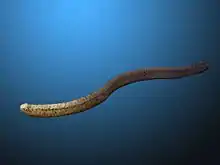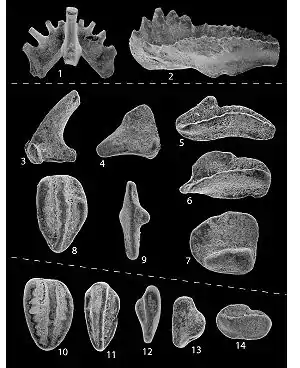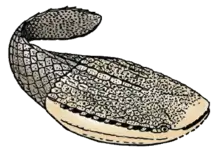Conodont
Conodonts (Greek kōnos, "cone", + odont, "tooth") are extinct agnathan chordates resembling eels, classified in the class Conodonta. For many years, they were known only from tooth-like microfossils found in isolation and now called conodont elements. Knowledge about soft tissues remains limited. The animals are also called Conodontophora (conodont bearers) to avoid ambiguity.
| Conodonts | |
|---|---|
| Reconstruction of a conodont | |
 | |
| Reconstruction of Hindeodus, showing arrangement of elements | |
| Scientific classification | |
| Kingdom: | Animalia |
| Phylum: | Chordata |
| Subphylum: | Vertebrata |
| Class: | †Conodonta Eichenberg 1930[1] |
| Groups | |
| |
| Synonyms | |
Conodonts are considered index fossils, fossils used to define and identify geological periods.
Geological history
The conodonts first appeared during the Cambrian Stage 2 (also referred as Tommotian).[3] The still unnamed Cambrian Stage 10 can be defined as the first appearance of Eoconodontus notchpeakensis. The upper boundary is defined as the appearance of Iapetognathus fluctivagus which marks the beginning of the Tremadocian and is radiometrically dated as 485.4 ± 1.9 million years ago.
The Cambrian–Ordovician extinction event occurred approximately 488 million years ago. This early Paleozoic extinction event extirpated many conodonts.
The Lau event, about 420 million years ago, a relatively minor mass extinction during the Silurian period, had a major impact on conodont populations.
The Kačák Event was a period of significant extinctions. The group most affected was the Ammonoidea, although there were also faunal turnovers amongst conodonts and dacryoconarids.[4]
The entire class is postulated to have been wiped out in the Triassic–Jurassic extinction event, which occurred roughly 200 million years ago.[5] Near the end of the Triassic deadly marine biocalcification began to occur, along with oceanic acidification, sea-level fluctuations and the Central Atlantic Magmatic Province (CAMP) releasing carbon dioxide, sulfur dioxide and aerosols. These environmental catastrophes caused the extinction of the conodonts, along with 34% of other marine genera.[6]
The last conodont species to appear, Neohindeodella detrei, existed at the very end of the Rhaetian. The youngest conodont specimen of this species was found in the earliest Hettangian of Hungary, when the final extinction of conodonts occurred.
Discovery and understanding of conodonts
Conodonts, that is, the teeth-like fossils, were first discovered by Heinz Christian Pander, the results published, in Saint Petersburg, Russia, in 1856.[7] The name pander is commonly used in scientific names of conodonts.
It was only in the early 1980s that the first fossil evidence was found of the rest of the animal (see below). In the 1990s exquisite fossils were found in South Africa in which the soft tissue had been converted to clay, preserving even muscle fibres. The presence of muscles for rotating the eyes showed definitively that the animals were primitive vertebrates.[8]
Description

The 11 known fossil imprints of conodont animals record an eel-like creature with 15 or, more rarely, 19 elements that form a bilaterally symmetrical array in the head.
The organisms range from a 1-40 cm (Promissum) in length.[9] Conodonts have large eyes, fins with fin rays, chevron-shaped muscles and a notochord.[10]
Elements

1. Kladognathus sp., Sa element, posterior view, X140 2. Cavusgnathus unicornis, gamma morphotype, Pa element, lateral view, X140
3–9. Conodonts from the uppermost Loyalhanna Limestone Member of the Mauch Chunk Formation, Keystone quarry, Pa. This collection (93RS–79b) is from the upper 10 cm of the Loyalhanna Member. Note the highly abraded and reworked aeolian forms.
3, 4. Kladognathus sp., Sa element, lateral views, X140
5. Cavusgnathus unicornis, alpha morphotype, Pa element, lateral view, X140
6, 7. Cavusgnathus sp., Pa element, lateral view, X140
8. Polygnathus sp., Pa element, upper view, reworked Late Devonian to Early Mississippian morphotype, X140
9. Gnathodus texanus?, Pa element, upper view, X140
10–14. Conodonts from the basal 20 cm of the Loyalhanna Limestone Member of the Mauch Chunk Formation, Keystone quarry, Pa. (93RS–79a), and Westernport, Md. (93RS–67), note the highly abraded and reworked aeolian forms
10. Polygnathus sp., Pa element, upper view, reworked Late Devonian to Early Mississippian morphotype, 93RS–79a, X140
11. Polygnathus sp., Pa element, upper view, reworked Late Devonian to Early Mississippian morphotype, 93RS–67, X140
12. Gnathodus sp., Pa element, upper view, reworked Late Devonian(?) through Mississippian morphotype, 93RS–67, X140
13. Kladognathus sp., M element, lateral views, 93RS–67, X140
14. Cavusgnathus sp., Pa element, lateral view, 93RS–67, X140
Conodont teeth are the earliest found in the fossil record.[11] The evolution of mineralized tissues has been puzzling for more than a century. It has been hypothesized that the first mechanism of chordate tissue mineralization began either in the oral skeleton of conodont or the dermal skeleton of early agnathans.
The element array constituted a feeding apparatus that is radically different from the jaws of modern animals. They are now termed "conodont elements" to avoid confusion. The three forms of teeth, i.e., coniform cones, ramiform bars, and pectiniform platforms, probably performed different functions.
For many years, conodonts were known only from enigmatic tooth-like microfossils (200 micrometers to 5 millimeters in length[12]), which occur commonly, but not always in isolation, and were not associated with any other fossil. Until the early 1980s, conodont teeth had not been found in association with fossils of the host organism, in a konservat lagerstätte.[13] This is because the conodont animal was soft-bodied, thus everything but the teeth was unsuited for preservation under normal circumstances.
These microfossils are made of hydroxylapatite (a phosphatic mineral).[14] The conodont elements can be extracted from rock using adequate solvents.[15][16][17]
They are widely used in biostratigraphy. Conodont elements are also used as paleothermometers, a proxy for thermal alteration in the host rock, because under higher temperatures, the phosphate undergoes predictable and permanent color changes, measured with the conodont alteration index. This has made them useful for petroleum exploration where they are known, in rocks dating from the Cambrian to the Late Triassic.
Multielement conodonts

The conodont apparatus may comprise a number of discrete elements, including the spathognathiform, ozarkodiniform, trichonodelliform, neoprioniodiform, and other forms.[18]
In the 1930s, the concept of conodont assemblages was described by Hermann Schmidt[19] and by Harold W. Scott in 1934.[20][21][22][23]
Elements of ozarkodinids
The feeding apparatus of ozarkodinids is composed at the front of an axial Sa element, flanked by two groups of four close-set elongate Sb and Sc elements which were inclined obliquely inwards and forwards. Above these elements lay a pair of arched and inward pointing (makellate) M elements. Behind the S-M array lay transversely oriented and bilaterally opposed (pectiniform, i.e. comb-shaped) Pb and Pa elements.[24]
Ecology
The "teeth" of some conodonts have been interpreted as filter-feeding apparatuses, filtering plankton from the water and passing it down the throat. Others have been interpreted as a "grasping and crushing array".[9] The preserved musculature suggests that some conodonts (Promissum at least) were efficient cruisers, but incapable of bursts of speed.[9]
A study on the population dynamics of Alternognathus has been published. Among other things, it demonstrates that at least this taxon had short lifespans lasting around a month.[25]
Classification and phylogeny
As of 2012, scientists classify the conodonts in the phylum Chordata on the basis of their fins with fin rays, chevron-shaped muscles and notochord.[26]
Milsom and Rigby envision them as vertebrates similar in appearance to modern hagfish and lampreys,[27] and phylogenetic analysis suggests they are more derived than either of these groups.[28] However, this analysis comes with one caveat: early forms of conodonts, the protoconodonts, appear to form a distinct clade from the later paraconodonts and euconodonts. Protoconodonts likely represent a stem group to the phylum that includes chaetognath worms; this conclusion suggests that chaetognaths are not close relatives of true conodonts.[29] Moreover, some analyses do not regard conodonts as either vertebrates or craniates, because they lack the main characteristics of these groups.[30]
| Craniata |
| ||||||||||||||||||||||||||||||||||||||||||||||||||||||||||||
Taxonomy
Conodonta taxonomy based on Sweet & Donoghue,[31][33] Mikko's Phylogeny Archive[34] and Fish classification 2017.[35]
Conodonta Pander 1856 non Eichenberg 1930 sensu Sweet & Donoghue 2001 [Conodontia; Conodontophorida Eichenberg 1930; Conodontochordata]
- Paraconodonta Müller 1962 [Paraconodontida]
- Amphigeisiniformes
- Amphigeisinidae Miller 1981
- Westergaardodiniformes Lindström 1970
- Westergaardodinidae Müller 1959 [Chosonodinidae]
- Furnishinidae Müller & Nogami 1971
- Amphigeisiniformes
- Conodontophora Eichenberg 1930
- Caviodonti Sweet 1988
- Proconodontiformes Sweet 1988
- Pseudooneotodidae Wang & Aldridge 2010
- Proconodontidae Lindström 1981
- Cordylodontidae Lindström 1970 [Cyrtoniodontinae Hass 1959]
- Fryxellodontina
- Fryxellodontidae Miller 1981
- Pygodontidae Bergstrom 1981
- Belodellina Sweet 1988
- Ansellidae Faohraeus & Hunter 1985
- Dapsilodontidae Sweet 1988
- Belodellidae Khodalevich & Tschernich 1973 [Cambropustulidae]
- Proconodontiformes Sweet 1988
- Conodonti Pander 1856 non Branson 1938
- Oneotodontidae Miller 1981 [Teridontidae Miller 1981]
- Protopanderodontida Sweet 1988 [Panderodontida]
- ?Pronodontidae Lindström 1970
- ?Cornuodontidae Faohraeus1966
- ?Protopanderodontidae Lindström 1970 [Juanognathidae Bergström 1981]
- ?Strachanognathidae Bergström 1981
- ?Pseudooneotodidae
- Clavohamulidae Lindström 1970
- Drepanoistodontidae Faohraeus 1978
- Acanthodontidae Lindström 1970
- Scolopodontidae Bergström 1981
- Panderodontidae Lindström 1970
- Prioniodontida Dzik 1976 [Distacodontida] (paraphyletic)
- ?Acodontidae Dzik 1993 [Tripodontinae Sweet 1988]
- ?Cahabagnathidae Stouge & Bagnoli 1999
- ?Distacodontidae Bassler 1925 emend. Ulrich & Bassler 1926 [Drepanodontinae Fahraeus & Nowlan 1978; Lonchodininae Hass 1959]
- ?Gamachignathidae Wang & Aldridge 2010
- ?Jablonnodontidae Dzik 2006
- ?Nurrellidae Pomešano-Cherchi 1967
- ?Paracordylodontidae Bergström 1981
- ?Playfordiidae Dzik 2002
- ?Ulrichodinidae Bergström 1981
- Rossodus Repetski & Ethington 1983
- Multioistodontidae Harris 1964 [Dischidognathidae]
- Oistodontidae Lindström 1970
- Periodontidae Lindström 1970
- Rhipidognathidae Lindström 1970 sensu Sweet 1988
- Prioniodontidae Bassler 1925
- Phragmodontidae Bergström 1981
- Plectodinidae Sweet 1988
- Icriodontacea
- Balognathidae (Hass 1959)
- Polyplacognathidae Bergström 1981
- Distomodontidae Klapper 1981
- Icriodellidae Sweet 1988
- Icriodontidae Müller & Müller 1957
- Prioniodinida Sweet 1988
- ?Oepikodontidae Bergström 1981
- ?Xaniognathidae Sweet 1981
- Chirognathidae Branson & Mehl 1944
- Prioniodinidae Bassler 1925 [Hibbardellidae Mueller 1956]
- Bactrognathidae Lindström 1970
- Ellisoniidae Clark 1972
- Gondolellidae Lindström 1970
- Ozarkodinida Dzik 1976 [Polygnathida]
- ?Anchignathodontidae Clark 1972
- ?Archeognathidae Miller 1969
- ?Belodontidae Huddle 1934
- ?Coleodontidae Branson & Mehl 1944 [Hibbardellidae Müller 1956; Loxodontidae]
- ?Eognathodontidae Bardashev, Weddige & Ziegler 2002
- ?Francodinidae Dzik 2006
- ?Gladigondolellidae (Hirsch 1994) [Sephardiellinae Plasencia, Hirsch & Márquez-Aliaga 2007; Neogondolellinae Hirsch 1994; Cornudininae Orchard 2005; Epigondolellinae Orchard 2005; Marquezellinae Plasencia et al. 2018; Paragondolellinae Orchard 2005; Pseudofurnishiidae Ramovs 1977]
- ?Iowagnathidae Liu et al. 2017
- ?Novispathodontidae (Orchard 2005)
- ?Trucherognathidae Branson & Mehl 1944
- ?Vjalovognathidae Shen, Yuan & Henderson 2015
- ?Wapitiodontidae Orchard 2005
- Cryptotaxidae Klapper & Philip 1971
- Spathognathodontidae Hass 1959 [Ozarkodinidae Dzik 1976]
- Pterospathodontidae Cooper 1977 [Carniodontidae]
- Kockelellidae Klapper 1981 [Caenodontontidae]
- Polygnathidae Bassler 1925 [?Eopolygnathidae Bardashev, Weddige & Ziegler 2002]
- Palmatolepidae Sweet 1988
- Hindeodontidae (Hass 1959)
- Elictognathidae Austin & Rhodes 1981
- Gnathodontidae Sweet 1988
- Idiognathodontidae Harris & Hollingsworth 1933
- Mestognathidae Austin & Rhodes 1981
- Cavusgnathidae Austin & Rhodes 1981
- Sweetognathidae Ritter 1986
- Caviodonti Sweet 1988
See also
Notes
- Here, the hagfish are treated as a separate clade, as in Sweet and Donoghue's 2001 tree produced without cladistic analysis.[31] However, it has been recognised by some[32] that the hagfish and lampreys may be closer to one another in their own clade, the Cyclostomata.
- The clade Proconodontida is also known as Cavidonti.
- Euconodonta is referred to as "Conodonti" by Sweet and Donoghue,[31] although this is not widely used.
References
- Eichenberg, W. (1930). "Conodonten aus dem Culm des Harzes". Paläontologische Zeitschrift. 12 (3–4): 177–182. doi:10.1007/BF03044446. S2CID 129519805.
- Sepkoski, J. J. (2002). "A compendium of fossil marine animal genera". Bulletins of American Paleontology. 363: 1–560.
- Early Cambrian (Tommotian) conodonts and other shelly microfauna from the Upper Krol of Mussoorie Syncline. RJ Azmi, VP Pancholi, Lesser Himalaya, with remarks on the Precambrian, 1983
- DeSantis, M.K.; Brett C.E. (2011). "Late Eifelian (Middle Devonian) biocrises: Timing and signature of the pre-Kačák Bakoven and Stony Hollow Events in eastern North America". Palaeogeography, Palaeoclimatology, Palaeoecology. 304 (1–2): 113–135. doi:10.1016/j.palaeo.2010.10.013.
- The extinction of conodonts —in terms of discrete elements— at the Triassic-Jurassic boundary
- Graham Ryder; David E. Fastovsky; Stefan Gartner (1996). The Cretaceous-Tertiary Event and Other Catastrophes in Earth History. Geological Society of America. p. 19. ISBN 9780813723075.
- Sweet, Walter C.; Cooper, Barry J. (December 2008). "C.H. Pander's introduction to conodonts, 1856". Retrieved 3 January 2019.
- Jan Zalasiewicz and Sarah Gabbott (Jun 5, 1999). "The quick and the dead". New Scientist.
- Gabbott, S.E.; R. J. Aldridge; J. N. Theron (1995). "A giant conodont with preserved muscle tissue from the Upper Ordovician of South Africa". Nature. 374 (6525): 800–803. Bibcode:1995Natur.374..800G. doi:10.1038/374800a0. S2CID 4342260.
- Foster, John (2014-06-06). Cambrian Ocean World: Ancient Sea Life of North America. Indiana University Press. pp. 300–301. ISBN 978-0-253-01188-6.
- Shubin, Neil (2009). Your Inner Fish: A Journey into the 3.5 Billion Year History of the Human Body (reprint ed.). New York: Pantheon Books. pp. 85–86. ISBN 9780307277459.
- MIRACLE. "Conodonts". Retrieved 26 August 2014.
- Briggs, D. E. G.; Clarkson, E. N. K.; Aldridge, R. J. (1983). "The conodont animal". Lethaia. 16 (1): 1–14. doi:10.1111/j.1502-3931.1983.tb01993.x.
- Trotter, Julie A. (2006). "Chemical systematics of conodont apatite determined by laser ablation ICPMS". Chemical Geology. 233 (3–4): 196–216. doi:10.1016/j.chemgeo.2006.03.004.
- Jeppsson, Lennart; Anehus, Rikard (1995). "A Buffered Formic Acid Technique for Conodont Extraction". Journal of Paleontology. 69 (4): 790–794. doi:10.1017/s0022336000035319. JSTOR 1306313.
- Green, Owen R. (2001). "Extraction Techniques for Phosphatic Fossils". A Manual of Practical Laboratory and Field Techniques in Palaeobiology: 318–330. doi:10.1007/978-94-017-0581-3_27. ISBN 978-90-481-4013-8.
- Quinton, Page C. (2016). "Effects of extraction protocols on the oxygen isotope composition of conodont elements". Chemical Geology. 431: 36–43. doi:10.1016/j.chemgeo.2016.03.023.
- Bergström, S. M.; Carnes, J. B.; Ethington, R. L.; Votaw, R. B.; Wigley, P. B. (1974). "Appalachignathus, a New Multielement Conodont Genus from the Middle Ordovician of North America". Journal of Paleontology. 48 (2): 227–235. doi:10.1666/0022-3360(2001)075<1174:CPPF>2.0.CO;2. JSTOR 1303249.
- Schmidt, Hermann (1934). "Conodonten-Funde in ursprünglichem Zusammenhang". Paläontologische Zeitschrift. 16 (1–2): 76–85. doi:10.1007/BF03041668. S2CID 128496416.
- Harold W. Scott, "The Zoological Relationships of the Conodonts. Journal of Paleontology, Vol. 8, No. 4 (Dec., 1934), pages 448-455 (Stable URL)
- Scott, Harold W. (1942). "Conodont Assemblages from the Heath Formation, Montana". Journal of Paleontology. 16 (3): 293–300. JSTOR 1298905.
- Dunn, David L. (1965). "Late Mississippian conodonts from the Bird Spring Formation in Nevada". Journal of Paleontology. 39: 6. Archived from the original on 2016-08-18. Retrieved 2016-07-15.
- Barnes, Christopher R. (1967). "A Questionable Natural Conodont Assemblage from Middle Ordovician Limestone, Ottawa, Canada". Journal of Paleontology. 41 (6): 1557–1560. JSTOR 1302203.
- Purnell, M. A.; Donoghue, P. C. (1997). "Architecture and functional morphology of the skeletal apparatus of ozarkodinid conodonts". Philosophical Transactions of the Royal Society B: Biological Sciences. 352 (1361): 1545–1564. Bibcode:1997RSPTB.352.1545P. doi:10.1098/rstb.1997.0141. PMC 1692076.
- Świś, Przemysław (2019). "Population dynamics of the Late Devonian conodont Alternognathus calibrated in days". Historical Biology: An International Journal of Paleobiology: 1–9. doi:10.1080/08912963.2018.1427088. S2CID 89835464.
- Briggs, D. (May 1992). "Conodonts: a major extinct group added to the vertebrates". Science. 256 (5061): 1285–1286. Bibcode:1992Sci...256.1285B. doi:10.1126/science.1598571. PMID 1598571.
- Milsom, Clare; Rigby, Sue (2004). "Vertebrates". Fossils at a Glance. Victoria, Australia: Blackwell Publishing. p. 88. ISBN 978-0-632-06047-4.
- Donoghue, P.C.J.; Forey, P.L.; Aldridge, R.J. (2000). "Conodont affinity and chordate phylogeny". Biological Reviews. 75 (2): 191–251. doi:10.1111/j.1469-185X.1999.tb00045.x. PMID 10881388. S2CID 22803015. Retrieved 2008-04-07.CS1 maint: multiple names: authors list (link)
- Szaniawski, H. (2002). "New evidence for the protoconodont origin of chaetognaths" (PDF). Acta Palaeontologica Polonica. 47 (3): 405.
- Turner, S., Burrow, C.J., Schultze, H.P., Blieck, A., Reif, W.E., Rexroad, C.B., Bultynck, P., Nowlan, G.S.; Burrow; Schultze; Blieck; Reif; Rexroad; Bultynck; Nowlan (2010). "False teeth: conodont-vertebrate phylogenetic relationships revisited" (PDF). Geodiversitas. 32 (4): 545–594. doi:10.5252/g2010n4a1. S2CID 86599352. Archived from the original (PDF) on 2012-03-19. Retrieved 2011-02-11.CS1 maint: multiple names: authors list (link)
- Sweet, W. C.; Donoghue, P. C. J. (2001). "Conodonts: Past, Present, Future". Journal of Paleontology. 75 (6): 1174–1184. doi:10.1666/0022-3360(2001)075<1174:CPPF>2.0.CO;2.
- Bourlat, Sarah J.; Juliusdottir, Thorhildur; Lowe, Christopher J.; Freeman, Robert; Aronowicz, Jochanan; Kirschner, Mark; Lander, Eric S.; Thorndyke, Michael; Nakano, Hiroaki; Kohn, Andrea B.; Heyland, Andreas; Moroz, Leonid L.; Copley, Richard R.; Telford, Maximilian J. (2006). "Deuterostome phylogeny reveals monophyletic chordates and the new phylum Xenoturbellida". Nature. 444 (7115): 85–88. Bibcode:2006Natur.444...85B. doi:10.1038/nature05241. ISSN 0028-0836. PMID 17051155. S2CID 4366885.
- Sweet, W. C. (1988). "The Conodonta: morphology, taxonomy, paleoecology and evolutionary history of a long-extinct animal phylum". Oxford Monographs on Geology and Geophysics (10): 1–211.
- Mikko's Phylogeny Archive Haaramo, Mikko (2007). "Conodonta - conodonts". Retrieved 2015-12-30.
- "Fish classification 2017". mayatan.web.fc2.com. Retrieved 2018-12-27.
Further reading
- Aldridge, R. J.; Briggs, D. E. G.; Smith, M. Paul; Clarkson, E. N. K.; Clark, N. D. L. (1993). "The anatomy of conodonts". Philosophical Transactions of the Royal Society of London, Series B. 340 (1294): 405–421. doi:10.1098/rstb.1993.0082.
- Aldridge, R. J.; Purnell, M. A. (1996). "The conodont controversies". Trends in Ecology and Evolution. 11 (11): 463–468. doi:10.1016/0169-5347(96)10048-3. PMID 21237922.
- Donoghue, P. C. J.; Forey, P. L.; Aldridge, R. J. (2000). "Conodont affinity and chordate phylogeny". Biological Reviews. 75 (2): 191–251. doi:10.1111/j.1469-185X.1999.tb00045.x. PMID 10881388. S2CID 22803015.
- Gould, Stephen Jay (1985). "Reducing Riddles". In The Flamingo's Smile, 245-260. New York, W.W. Norton and Company. ISBN 0-393-30375-6.
- Janvier, P (1997). "Euconodonta". The tree of life web project. Retrieved 2007-09-05.
- Knell, Simon J. The Great Fossil Enigma: The Search for the Conodont Animal (Indiana University Press; 2012) 440 pages
- Sweet, Walter. The Conodonta.
- Sweet, W. C.; Donoghue, P. C. J. (2001). "Conodonts: past, present and future". Journal of Paleontology. 75 (6): 1174–1184. doi:10.1666/0022-3360(2001)075<1174:CPPF>2.0.CO;2. ISSN 0022-3360.
- Lindström, Maurits (1970). "A suprageneric taxonomy of the conodonts". Lethaia. 3 (4): 427–445. doi:10.1111/j.1502-3931.1970.tb00834.x.
External links
- Mark Purnell. "An oblique anterior view of a model of the apparatus of the Pennsylvanian conodont Idiognathodus".
- "'The Jaws That Catch': an Introduction to the Conodonta". Palæos. Retrieved 2013-07-01.
- Jim Davison (2002-10-15). "Ordovician conodonts". Retrieved 2009-07-07.
